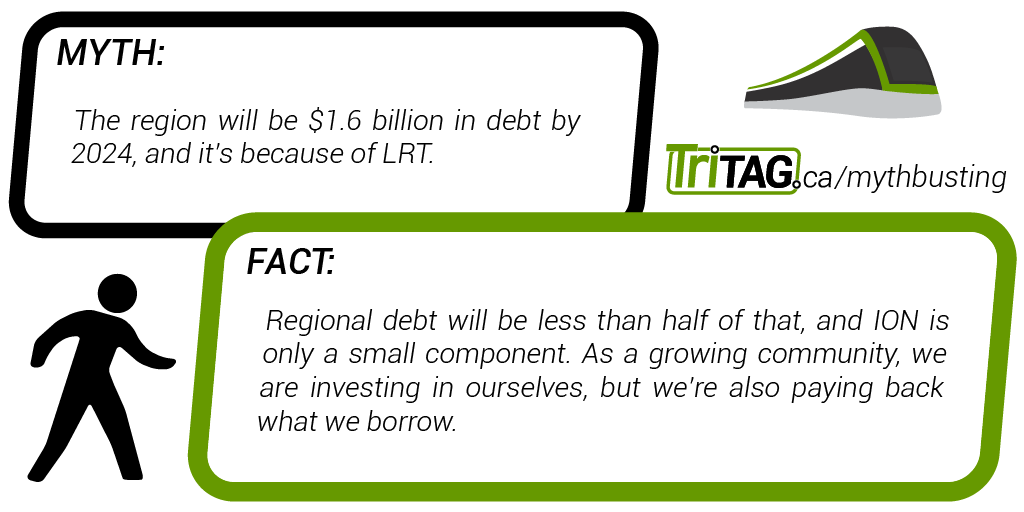Myth #4: "We will be $1.6 billion in debt by 2024."
Yesterday, we covered how cancelling ION would result in an additional half a billion dollars’ road costs, straining regional taxpayers and adding new debt. So it’s interesting that LRT opponents’ main platform plank is how LRT is a major part of raising debt up to a whopping $1.6 billion in 10 years.
A whopping figure, and a real “whopper” too. Around TriTAG, it’s a hard to keep our heads above the steady flow of misinformation, so lucky for us, journalist Mike McCulloch has already performed an in-depth analysis of this adventurous claim. What does he find out?
“…it appears Bowers’ and Aissa’s projection is again failing to account for annual debt repayments.
“The debt outstanding at the end of 2023 based on our 2014 capital plan would be $755 million,” [Director of Treasury Services] Hinchberger said.
“So it’s half of the $1.5 billion that’s quoted [by Aissa’s campaign] because the $1.5 billion does not take into account the debt repayment that’s happening every year across those ten years,”
In addition, the region historically under-spends on its capital plan and issues less debt than expected, a fact that Moody’s Investor Service praises the municipality for in the firm’s latest AAA credit rating of the municipality’s finances.”
Now, is the debt claim $1.5 billion, or $1.6 billion? It depends. If you read Aissa’s latest flyer, it says 1.6 billion, but it also says 41.6 billion! But either way, it doesn’t matter, because it’s wrong. It’s like counting up all the money you spend through your credit card and claiming you’ll be that far in debt, without even checking if you’re paying it off every month.
What to make of this? Mike McCulloch goes on to say:
“At best, it would appear the figure is an accounting oversight by Bowers when researching campaign messaging, mistakenly omitting debt retirement from the equation.
At worst, one might gather the $1.5 billion figure is a willful manipulation of the facts. What end would that serve? Well, I’ll leave that for you to decide.”
No matter which way we take this claim, it reflects very poorly on the candidates making them.
(You can read all of Mike McCulloch’s analysis here.)
Now what about this idea of how cancelling LRT would save us from debt? Firstly, the debt issued by the region for ION is expected to be $104.5 million. Their project partner, GrandLinq, will have debt of their own to worry about. They’ll get that back gradually, covered in ION’s operating expenses which we discussed on Tuesday. And if they don’t provide good enough service… they don’t get paid.
When it comes down to it, given how ION is saving us money and helping us grow more sustainably, a little debt goes a long way. Regardless, $104 million (while not chump change) is only a small fraction of debt, be it $755 million, $1.6 billion, or $41.6 billion.
This is probably the biggest, boldest myth needing busting. As Mike McCulloch put it, at best someone made a big mistake. But it’s possible that someone is hoping that if they repeat it often enough, you won’t stop to question its very questionable accuracy.
And who knows, by tomorrow the claim might be $41.6 billion in debt after all.
- Mythbusting the election: Candidates said it, but can they back it up?
- TriTAG Election Candidate Survey: Find out where candidates stand on ION and transit!
- ION’s route, animated: Think it’s just a mall to mall train? Think again.
- ION Infographic: Find out the facts about ION, and how it will benefit you.

